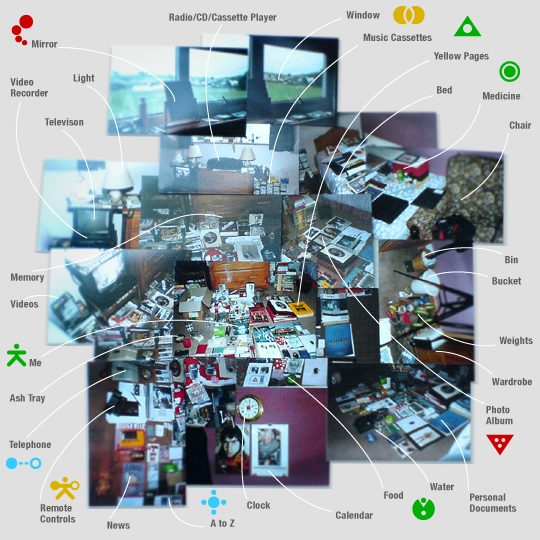| |
|
|
 |
|
| Do
We Really Long to be Back in the Womb? |
My
gut instinct would be... yes. Before you branch off into vision of
a fetus swimming around in placenta - think about the prospect for
a moment. Where were you the most protected? Where was the only place
you were always warm, safe and never hungry? Instead of a vision of
a half formed human in slime, imagine a soft warm welcoming place
in which you never have to open your eyes in fear of the surroundings.
Now, close your bedroom door then arrange everything you need to survive
on the floor and walls of your "cave".
Sigmund Freud, the Austrian physician, neurologist, and founder of
psychoanalysis, who created an entirely new approach to the understanding
of human personality. Through his skill as a scientist, physician,
and writer, Freud combined ideas prevalent at the time with his own
observation and study to produce a major theory of psychology. Most
importantly, he applied these ideas to medical practice in the treatment
of mental illness. His newly created psychotherapy treatments and
procedures, many of which in modified form are applied today, were
based on his understanding of unconscious thought processes and their
relationship to neurotic symptoms. Regarded with skepticism at the
time, Freud’s ideas have waxed and waned in acceptance ever
since. Nevertheless, he is regarded as one of the greatest creative
minds of the 20th century.
Freud’s observation of Jean Charcot’s use of
hypnosis in the treatment of similar disorders led him to conclude
that there could be powerful mental processes operating that remain
hidden from conscious understanding. He began to employ hypnosis in
his own practice, publishing articles on the subject in 1892. Freud
came to understand hysterical neurotic symptoms as the product of
a conflict between opposing mental forces. Conscious forces representing
“will” were balanced by unconscious opposing forces representing
“counterwill.”
Dreams
The next development in Freud’s theory stemmed
from his observations on dreaming. He came to see that many of the
characteristics of dreams were shared with the symptomatic memories
recalled by his patients in the narrative of “free association.”
In his therapeutic relationship with his patients, Freud had abandoned
hypnotic suggestion in favor of encouraging the person to speak freely
about whatever came into his or her mind. Unintentionally, the patient
would bring order to these free associations, whose structure and
content Freud used to try to understand underlying unconscious processes.
In dreams Freud noted the same apparently unstructured
experiences of thoughts and images coming into the mind that seemed
to be representative of some underlying unconscious process. To explain
these phenomena, he suggested the existence of an inner censor that
effected a compromise between conflicting mental forces and in the
process disguised their meaning from conscious appreciation. He defined
“resistance” as the unconscious defense against awareness
of repressed experiences in order to avoid the resulting anxiety.
He traced the operation of unconscious processes, using the free associations
of the patient to guide him in the interpretation of dreams and slips
of speech. Slips of speech or parapraxes, now known as “Freudian
slips,” Freud claimed, were revelations of unconscious wishes.
His 1904 publication, The Psychopathology of Everyday Life, discusses
these ideas.
Freud came to understand the mind as a series of layers,
with the most superficial layers in conscious appreciation and the
deeper layers containing repressed memories and remaining unavailable
to conscious thought. He termed this the topographical model and likened
it to an iceberg, a small part of which is visible above the surface
while the greater submerged part remains obscured from view. These
ideas were published in 1900 in The Interpretation of Dreams.
During the first two decades of the 1900s Freud
concentrated on modifying and improving his theory of psychoanalysis.
He defined a number of principles and described a model of personality
development.
The Unconscious
Perhaps Freud’s greatest contribution was to describe
the unconscious and to postulate that it obeys the principle of psychic
determinism, which holds that human thoughts, feelings, and impulses,
rather than being random, are linked in a system of causally related
phenomena, behind which lies some reason or meaning. Freud concluded
that on this basis unconscious processes could be investigated and
understood. Some experiences that are not immediately accessible to
conscious appreciation can be brought into the conscious mind by the
process of remembering. Freud referred to these experiences as the
preconscious. Still-deeper thoughts cannot be remembered and are actively
repressed in the unconscious.
Unconscious experiences, according to Freud, are not subject
to the same logic characteristic of conscious experience. Unconscious
ideas, images, thoughts, and feelings can be condensed or dramatized
in the form of abstract concepts and imagery. Often the relationship
between the original experience and the unconscious symbolic representation
can seem obscure.
Role of Conflict
The central theme of conflict had arisen early
in Freud’s work. Conflict arises in a person’s conscious
mind when one set of beliefs impacts adversely on another area of
belief, causing emotional suffering felt as disappointment, anger,
or frustration. Freud was interested in the unconscious aspect of
mental conflict. He described the “pleasure principle”
as another fundamental of psychoanalytic theory. This holds that human
beings have a tendency to seek pleasure and avoid pain. The principle
is said to dominate in early life, bringing the developing individual
into conflict with the external world. These conflicts are retained
in the unconscious.
Freud’s original concept held that the conflicts of
early life arose as a result of innate human drives or instincts.
He conceptualized how development might occur in terms of the drives
and their satisfaction according to the pleasure principle. Among
the chief drives was the libidinal, or sexual, drive, which serves
the human species by directing individuals to reproduce. Awareness
of a need to keep rein on the free expression of drives gradually
develops, and failure to rein in these drives (and fantasies about
their expression) is felt as guilt. Life becomes an equilibrium between
drives, conflicts, and reality. Freud believed that by
understanding the crucial events and fantasy wishes of childhood,
psychoanalysis could shed understanding on later adult character development
with its attendant conflicts and neurotic symptoms. Later, he extended
his model to include psychoses (serious mental disorders in which
people have a distorted view of reality).
Conflicts repressed into the unconscious are retained, according
to Freud. From time to time they may overcome repression and reemerge
into conscious appreciation, precipitating anxiety or panic. To counteract
this, the individual unconsciously produces various defense mechanisms,
which become part of that person’s character. Examples of defense
mechanisms include projection, where the individual ascribes to others
his or her own unconscious desires (“I hate you,” for
example, becomes “You hate me”), and reaction formation,
where the individual adopts a pattern of behavior directly opposed
to a strong unconscious drive. In 1923 Freud reformulated his
ideas in a structural model of the mind that postulated the existence
of the id, the ego, and the superego.
Freud gave the name “id” to unconscious drives. The id
knows nothing of morality or reality. It seeks only to gratify the
instinctual drives, and it operates solely according to the pleasure
principle. Freud held that the biological drives of a young person
are often frustrated by delays and restricted by the demands of parents
and other older members of the family. As time passes, the demands
of the community or society also become important obstacles to id
gratification. In adapting to the environment, the child begins to
acquire an ego, or set of conscious perceptions, memories, and thoughts
that enable the person to deal effectively with reality. Thus, according
to Freud, the ego obeys the reality principle. As the individual absorbs
the teachings of family and society, he develops a superego, or conscience,
that frequently conflicts with the drives of the id. In many cases
the ego reduces the conflict by at least partially fulfilling the
id impulses through socially acceptable behavior. Often, however,
the conflict disappears on the conscious level as unfulfilled impulses
are repressed into the unconscious mind.
Freud’s therapy consisted of listening to the patient
relate a narrative of free associations over many sessions. By listening
to the patient’s associations, Freudian slips, contents of dreams,
and thoughts, he linked and interpreted these experiences to the patient’s
conscious world. He came to understand the nature of “transference,”
in which the patient develops feelings for the therapist that are
in fact representative of previous feelings toward other important
figures in the patient’s life. These thoughts and feelings Freud
interpreted and linked to the patient’s current emotional state.
|
|


